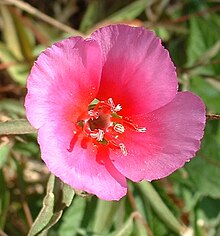Clarkia amoena, commonly known as farewell to spring, godetia, or satin flower, is a species of flowering plant native to western North America. It is found in coastal hills and mountains from British Columbia south to the San Francisco Bay Area of California.
| Clarkia amoena | |
|---|---|

| |
| Scientific classification | |
| Kingdom: | Plantae |
| Clade: | Tracheophytes |
| Clade: | Angiosperms |
| Clade: | Eudicots |
| Clade: | Rosids |
| Order: | Myrtales |
| Family: | Onagraceae |
| Genus: | Clarkia |
| Species: | C. amoena
|
| Binomial name | |
| Clarkia amoena (Lehm.) A.Nels. & J.F.Macbr
| |
This annual herb produces showy pink to lavender flowers and is known for its late spring to early summer blooming period. The species was formerly classified in the genus Godetia, and is still sometimes referred to by the synonym Godetia amoena.
Description
editIt is an annual plant growing to 1 m tall, with slender, linear leaves 2–7 cm long and 2–6 mm broad. The flowers are pink to pale purple, with four broad petals 1.5–6 cm long. The fruit is a dry capsule, which splits open when mature to release the numerous seeds.
Taxonomy
editFive subspecies are currently recognised, although intermediate forms are commonly found:[1]
- Clarkia amoena subsp. amoena (Lehm.) A. Nelson & J. F. Macbr. – (farewell to spring)[2]
- Clarkia amoena subsp. caurina (Abrams) C.L. Hitchc. – (northwestern farewell to spring)[3]
- Clarkia amoena subsp. huntiana (Jeps.) F.H. Lewis & M.E. Lewis – (Hunt's clarkia)[4]
- Clarkia amoena subsp. lindleyi (Dougl.) C.L. Hitchc. – (Lindley's clarkia)[5]
- Clarkia amoena subsp. whitneyi (A. Gray) H. Lewis & M. Lewis. – (Whitney's farewell to spring)[6]
Cultivation
editFarewell to spring is commonly cultivated as a garden plant, and cultivated varieties are known.
It a cool season plant and will tolerate temperatures below 0 °C (32 °F) in gardens or greenhouses. It flowers faster under long day conditions.[7] The plants grow best with minimal fertilizer. Popular cultivars introduced in the 1980s include cut flower (tall; 'Grace') and potted plant (short; 'Satin') types.
A gallery of cultivars is presented below.
-
'Cattleya'
-
'Duke of York'
-
'Furora'
-
'Grace Lavender with Eye'
-
'Grace Lavender'
-
'Grace Red'
-
'Grace Rose Pink'
-
'Grace Salmon'
-
'Kelviden Glory'
-
'Kyohuhai'
-
'Maidenblush'
-
'Miss Nagasaki'
-
'Sweetheart'
-
'White Bouquet'
-
Clarkia amoena at Gamble Garden in Palo Alto, California
References
edit- ^ Young-Mathews, A. 2012. Plant fact sheet for farewell to spring (Clarkia amoena). USDA-Natural Resources Conservation Service, Corvallis Plant Materials Center, Corvallis, OR.
- ^ "Clarkia amoena ssp. amoena Calflora". www.calflora.org. Retrieved 2024-07-01.
- ^ "OregonFlora | Clarkia amoena ssp. caurina". oregonflora.org. Retrieved 2024-07-01.
- ^ "OregonFlora | Clarkia amoena ssp. huntiana". oregonflora.org. Retrieved 2024-07-01.
- ^ "E-Flora BC Atlas Page | Clarkia amoena subsp. lindleyi". linnet.geog.ubc.ca. Retrieved 2024-07-01.
- ^ "Clarkia amoena ssp. whitneyi Calflora". www.calflora.org. Retrieved 2024-07-01.
- ^ Utami, L., Anderson, R. G., Geneve, R. L., & Kester, S. (1990). Effect of supplemental and photoperiodic lighting on flowering of satin flower. HortScience, 25(9), 1090c-1090.
External links
edit- Jepson Flora Project: Clarkia amoena
- Clarkia amoena at CalPhotos, UC Berkeley
- Plants of British Columbia: Clarkia amoena Archived 2016-03-03 at the Wayback Machine
- Pink, A. (2004). Gardening for the Million. Project Gutenberg Literary Archive Foundation.
